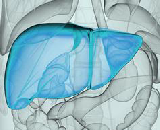Hepatic Fibrosis (HF)
Liver Fibrosis

Hepatic fibrosis (Live fibrosis) is the result of an imbalance between production and dissolution of extracellular matrix. Stellate cells, portal myofibroblasts, and bone marrow derived cells converge in a complex interaction with hepatocytes and immune cells to provoke scarring in response to liver injury. Uncovering the specific effects of growth factors on these cells, defining the interaction of different cell population during liver fibrosis and characterizing the genetic determinants of fibrosis progression will enable the discovery of new therapeutic approaches. The outcome of improved understanding of liver fibrosis process, especially the regulation and activation of stellate cells, is reflected in the development of new therapeutic strategies, which are validated in animal models. The most often used animal models for hepatic fibrosis are induced by carbon tetrachloride (CCl4) and bile duct ligation in rats.
Organism species: Mus musculus (Mouse)
- Disease model DSI520Mu01 Mouse Model for Hepatic Fibrosis (HF) In Stock
- Disease model DSI520Mu02 Mouse Model for Hepatic Fibrosis (HF) In Stock
- Customized Service n/a Tissue of Hepatic Fibrosis (HF) (If Necessary) Tissue Customized Service Offer
- Customized Service n/a Serums of Hepatic Fibrosis (HF) (If Necessary) Serums Customized Service Offer
Organism species: Rattus norvegicus (Rat)
- Disease model DSI520Ra01 Rat Model for Hepatic Fibrosis (HF) In Stock
- Disease model DSI520Ra02 Rat Model for Hepatic Fibrosis (HF) In Stock
- Disease model DSI520Ra03 Rat Model for Hepatic Fibrosis (HF) In Stock
- Customized Service n/a Tissue of Hepatic Fibrosis (HF) (If Necessary) Tissue Customized Service Offer
- Customized Service n/a Serums of Hepatic Fibrosis (HF) (If Necessary) Serums Customized Service Offer
Organism species: Cavia (Guinea pig )
- Disease model DSI520Gu01 Cavia Model for Hepatic Fibrosis (HF) In Stock
- Disease model DSI520Gu02 Cavia Model for Hepatic Fibrosis (HF) In Stock
- Customized Service n/a Tissue of Hepatic Fibrosis (HF) (If Necessary) Tissue Customized Service Offer
- Customized Service n/a Serums of Hepatic Fibrosis (HF) (If Necessary) Serums Customized Service Offer
Organism species: Oryctolagus cuniculus (Rabbit)
- Disease model DSI520Rb01 Rabbit Model for Hepatic Fibrosis (HF) In Stock
- Disease model DSI520Rb02 Rabbit Model for Hepatic Fibrosis (HF) In Stock
- Customized Service n/a Tissue of Hepatic Fibrosis (HF) (If Necessary) Tissue Customized Service Offer
- Customized Service n/a Serums of Hepatic Fibrosis (HF) (If Necessary) Serums Customized Service Offer
Organism species: Canis familiaris; Canine (Dog)
- Customized Service n/a Model for Hepatic Fibrosis (HF) Disease Model Customized Service Offer
- Customized Service n/a Tissue of Hepatic Fibrosis (HF) (If Necessary) Tissue Customized Service Offer
- Customized Service n/a Serums of Hepatic Fibrosis (HF) (If Necessary) Serums Customized Service Offer


